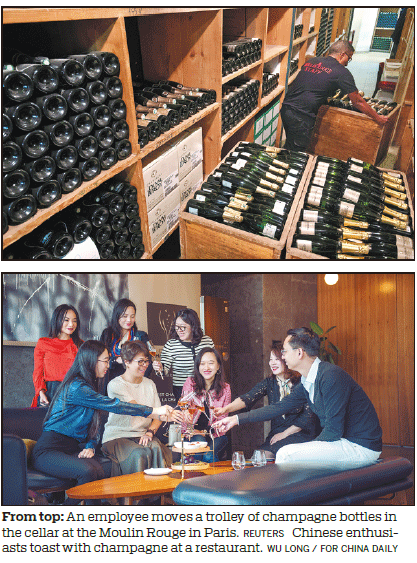More Chinese toasting champagne
Fan Yibo, a 45-year-old travel blogger from Beijing, just fizzes with excitement about champagne. He fell in love with the iconic French tipple on a visit to the country's Champagne region in 2010 and hasn't looked back since, ordering it on flights and in restaurants wherever he goes.
He says his annual spend on champagne is about 8,000 yuan ($1,136).
"I love the taste and sensation of champagne," Fan said. "Besides, when the bottle is opened, the bubbles gush out, creating an atmosphere full of joy."
Champagne, which has a long tradition in France, is becoming more present in the Chinese consciousness, with many now choosing it for special occasions.
Imports of champagne to the Chinese mainland have seen double-digit growth in recent years - a 52 percent increase in 2017 and 10 percent in 2018, data from the French Champagne Bureau in China showed.
Last year, the Chinese mainland imported about 2.17 million bottles of champagne, surpassing Hong Kong for the first time. Back in 2004, the number was just about 260,000 bottles.
In terms of global imports, the Chinese mainland ranked 20th in 2016, 15th in 2017 and 13th last year.
Imports of champagne were valued at around 41 million euros ($45.6 million) in the Chinese mainland in 2018, the bureau said.
The product is a high-end commodity with its price ranging from over 300 yuan to 1,000 yuan, higher on average than similar alcoholic products such as wine.
The high price comes from its scarcity - only 300 million bottles are produced every year, half of which are consumed in France. According to the geographical indication protection, only champagne produced in the Champagne area of France can be called "champagne". Other products must be labeled "sparkling wine".
The unique soil, water, temperature and fermentation techniques of the Champagne area give it a slightly acidic taste and carbonation, resulting in the iconic "pop "when the cork is pulled.
Generally, it takes about four to five years from picking the grapes to putting the product into the market, said Wang Wei, head of the French Champagne Bureau in China.
She added the limited production, the long and complex fermentation process and high cost in cultivation, define the high price.
"Champagne is a measurement for the economic development of a country," she said. "As an old saying goes, 'good food should be paired with good wine.' Champagne meets the demand of Chinese consumers who are seeking a high quality of life."
Edouard Duval, CEO of Shanghai-based East Meets West Fine Wines and a sixth generation member of the Duval-Leroy family in France, said sales of its champagne brand Duval-Leroy enjoy continuous growth year after year in the Chinese market. Its sales have grown 2 percent in volume and 8 percent in value year-on-year compared with 2018.
He sees clear potential for high-end cuvees, vintage champagne, small production cuvees and Grand Crus cuvees, which suggests China is becoming a premium market for champagne consumption.
In China, champagne is mostly seen in hotels, restaurants and bars - or the so-called on-trade markets where champagne is immediately drunk after purchasing, according to Wang.
In the off-trade markets like supermarkets and chain stores, champagne is not commonly seen, as retailers are still cautious, she added.
Duval said on-trade markets now contribute 60 percent of sales, while sales to private customers account for about 20 percent of total sales, but are also growing.
He added the role of champagne in China has seen a shift in recent years from a nightclub or nightlife pairing to something more linked with gastronomy.
Besides Western restaurants, Chinese restaurants have also begun to introduce champagne. Sheng Yong Xing Roast Duck Restaurant in Beijing, for example, hosted a champagne month in June to sell its duck and rose champagne together, saying "the sour taste of champagne can be an ideal complement to the greasy duck". Other brands like Beijing-based DaDong Duck and seafood restaurant Xin Rong Ji based in Zhejiang province have also followed the trend.
Duval said nowadays there are many new Chinese champagne lovers in their 30s who travel the world and like the sophistication and elegance of champagne.
"Though China is still a young market for champagne, we do expect the market to continue to evolve with more new cities opening to champagne, more people getting educated about champagne and more linkage created between champagne and gastronomy."
According to Wang, champagne houses have recognized the potential of the Chinese market and conducted related promotions, and are often present at major conventions like the China Food and Drinks Fair.
To expand business in China, she suggested champagne houses visit Chinese importers, retailers and consumers face to face.

(China Daily 11/06/2019 page14)














